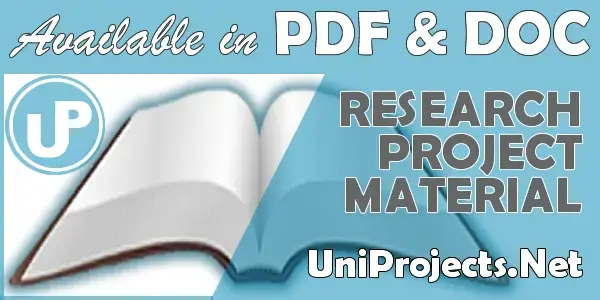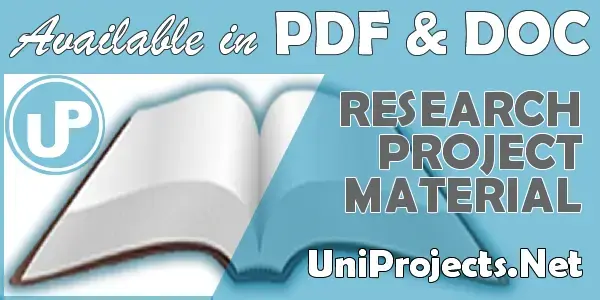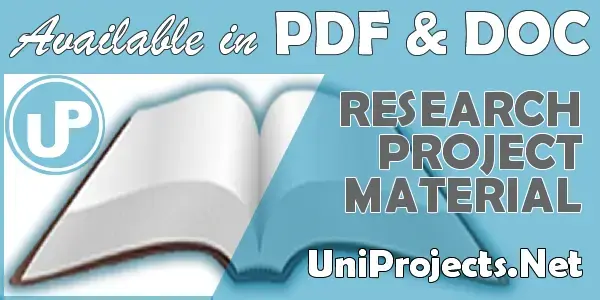Evaluation Of The Need For Quality Control And Inspection In An Organization
Chapter One
INTRODUCTION
1.1 BACKGROUND OF THE STUDY
A critical evaluation of the need for quality control and inspection of materials in various organizations have proved them so indispensable because of the huge sum of money involved in the procurement of materials. It has been observed that over 60% of many organizations budget is in material procurement. It is therefore necessary that materials which meet the required quality are purchased.
Prior to industrial revolution and standardization, the operation of quality control and inspection should be left in the hands of qualified and aggressive personnel.
Quality is now the responsibility of organizations; consequently, quality specification must be designed in a clear, crucise and accurate terms such that they are understandable by the broad spectrum of specialist. Inspection as a complement to quality control must not be dispensed in ensuring and maintaining end term quality.
the buyer, as a specialist must function in one of the more sensitive areas of quality control and inspection in negotiation and implementation of legal contract and purchase order.
1.2 STATEMENT OF PROBLEM
Ranging from small and large organizations, public and private firms, the problem of quality control and inspection has been found enormously common in their operation. Based on information obtained in some visited firms, quality control and inspection encountered so many shortcomings such as
1 Lack of good controlling organisation procedures
2 In-proper definition and organisation
3 Lack of qualified personnel
4 Lack of commitment in ensuring specified quality by operators
5 Jumping inspection procedures because of in-skill, lack of inspection materials and some times fatigue of personnel due to poor working environment.
Problem of quality control and inspection has rendered some organisations un stable in their area of operation as a result of not fully implementing and ensuring that quality is maintained from procurement to output.
As gathered so far from interviews, many organisations solely depend on the guarantee given to them by the producer which some times fails at their own peril. While some does not deem it necessary to intensify inspection.
Information also indicates that some organisations stipulate good and standardised quality goals but were just there fore writing and documentation sake, no implementation while some concentrate in product processing. This is where they focus to implement quality control while abandoning inspection and controlling quality first before inputting into production process.
The worst problem obtain so far in some organisation is that they consider quality control impossible and not necessary, and also regard inspection as a waste of time and resource, they believe that so far your product is presented and consumed controlling quality and inspection of materials is not vital.
So far, it has been obtained that the problem of quality control and inspection originates from misconception, to lack of qualified personnel’s, lack of commitment and implementation and finally to no regards and proper provision for quality control and inspection.
1.3 THE OBJECTIVES OF THE STUDY
The researcher having found out some problems faced by small and large organisations in the study of this work the need for quality control and inspection.
Organisations have failed to understand while there is so many waste products and cost incurred, as a result of no commitment in controlling quality and organised inspection programme.
The researcher plans to use this work to unveil the need for quality control and proper inspection of procured materials and also to draw the conscience of managers, store controllers, purchasers and other functionaries in an organisation to see reasons and understand the need to control quality and effect inspection in their organisation.
Quality start from input to output and the probability of turning inferior input to superior output is not there, this work intends to address the misconception of organisations concentrating to control quality or to achieve their quality objective at production process stage, while giving little or no regards to inspecting the input before acceptance.
Management of organisations should set a systematic and organised inspection unit and provide a sound laboratory testing equipments for those technical materials.
In-fact, the need for specialisation can not be over emphasised in those department concerned with quality and inspection to ensure good qualitative output (product), profitability and reduced cost.
1.4 THE RELEVANCE OF THE STUDY
This study will be an eye opener to organisations to be aware of the need for quality control and inspection and to realise their short sightedness in the area of focus for quality realisation.
The researcher aims to benefit the small and large organisations through this work by exposing the responsibility for quality, re-focusing managers, purchasers, and production managers from shallow regards given to quality control from the point of purchase to the needs to ensure quality control and inspection at first in purchasing and every stage of production.
This work will also benefit the new organisation to be cognisance and acquainted with measures, factors and techniques of controlling quality and method and process of inspection. Understanding this will lead to effective cost reduction and profit maximisation.
In a nutshell, this study will benefit both the buying and selling organisation whether small or large.
1.5 RESEARCH QUESTION
In the process of research and investigation on this project work, the researcher has been able to conduct this research with the following research questions.
1 Does your company have a separate quality control department?
2 Is it true that quality control brings about increase in product and revenue?
3 Do the quality control department involved in material inspection?
4 Do you have inspection department or does inspection exercise done by the user department?
5 Does inspection ensures quality product and burst profitability?
6 Does quality control measures applied in all departments of your organisation such as marketing, production and purchasing?
1.6 THE SCOPE OF THE STUDY
This study is not only focused on the need for quality control and inspection in an organisation but will equally look on the areas of organisational management structure, and financial capacity as a basis for quality controlling and inspection level and system.
This work will also uncover requirements, measures and importance of quality control and inspection to foster quality output and increase revenue.
1.7 THE LIMITATION OF THE STUDY
As a result of the importance on the area of quality control and inspection, the writer tends to cover the need for quality control and inspection in an organisation.
The paper would have gone beyond this, if not for
1 Financial constraint prevalent today
2 The time needed to run round information data
3 The attitude of most quality and inspection managers will be interviewed.
4 Other factors limiting the study is the non availability of quality control text by Nigeria authors, and the cost of writing materials to be bought from standard organisation of Nigeria (SON) is too cost.
5 Attitude of Nigerians to research, the tendency of people (corresponds) in regards to questionnaire not been important, as well as the nonchalant attitude of people to research in this country, due to some questionnaires not returned, some of which were returned did not comply with instructions of the research questionnaire. This militates adversely against the progress of this work. However, the research has made up these shortcomings from use of interviews and observation in some company/organisation.
Chapter Two: Literature Review
2.0 INTRODUCTION:
This chapter provides the background and context of the research problems, reviews the existing literature on the Evaluation Of The Need For Quality Control And Inspection In An Organization, and acknowledges the contributions of scholars who have previously conducted similar research [REV23621] …
Table of Content
Title page
Approval page
Dedication
Acknowledgement
Table of content
CHAPTER ONE
Introduction
1.1 Background of the study
1.2 Statement of problem
1.3 The objective of the study
1.4 The relevance of the study
1.5 Research question
1.6 The scope of the study
1.7 The limitation of the study
CHAPTER TWO
Literature review
2.1 Responsibility for quality control and inspection
2.2 Description of quality
2.3 Dimension of quality
2.4 Selection of supplier
2.5 Inspection
2.6 Methods of inspection and types
2.7 Rejection
CHAPTER THREE
3.1 Discussion of findings from the conceptual literature
CHAPTER FOUR
Summary, Conclusion and Recommendation
4.1 Summary
4.2 Conclusion
4.3 Recommendation
Bibliography










